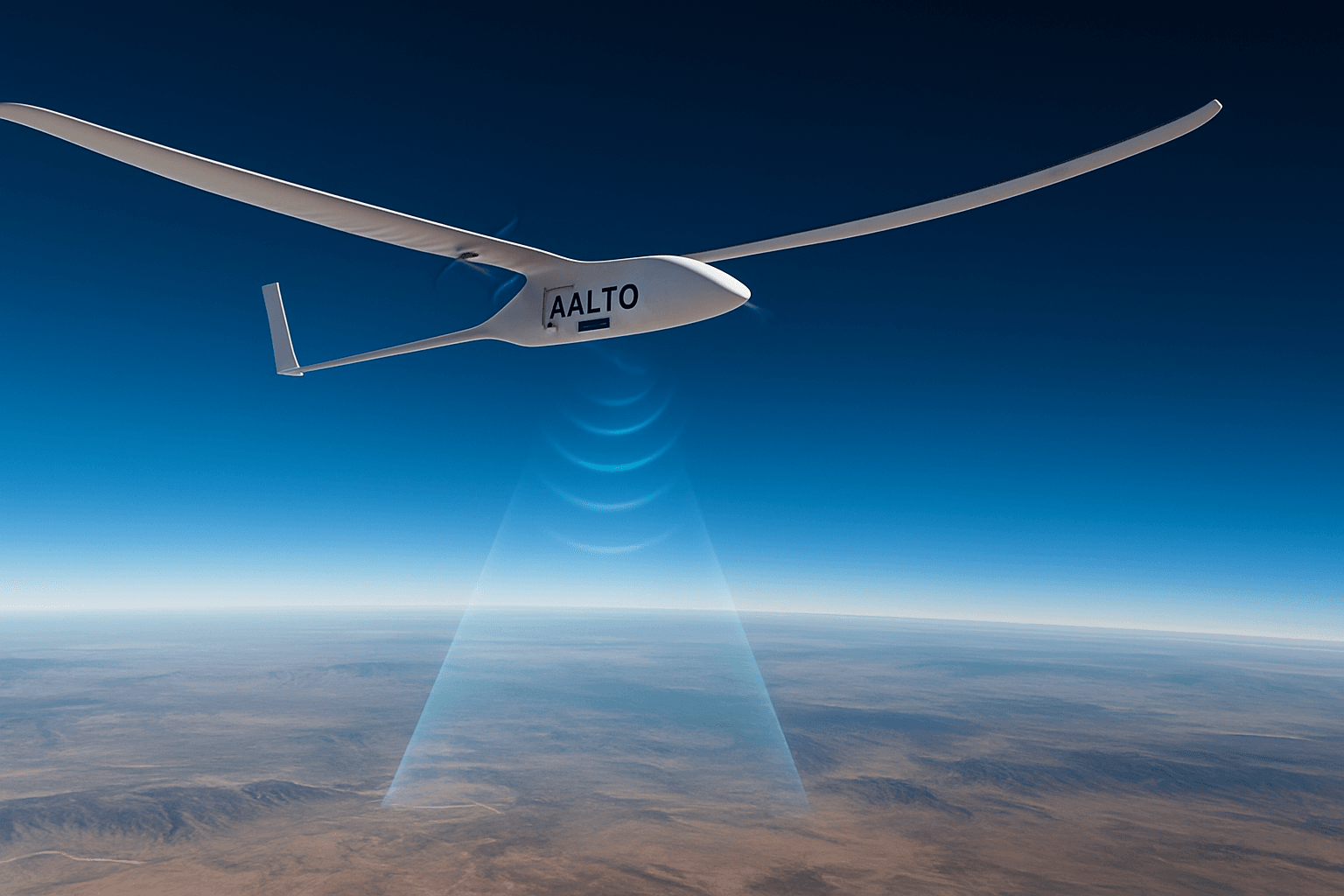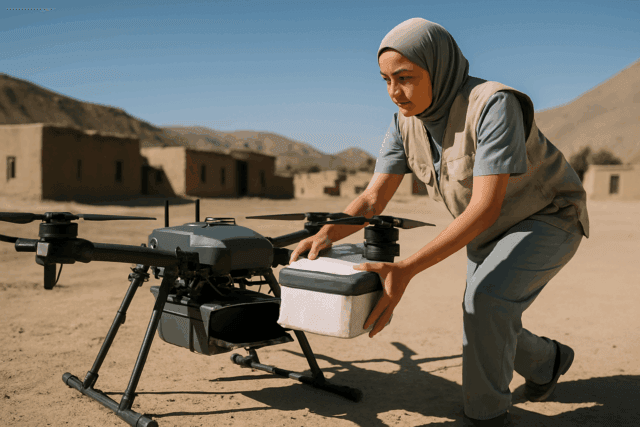AALTO HAPS Ltd., an Airbus subsidiary, has achieved a groundbreaking milestone with its Zephyr High Altitude Platform Station (HAPS). The Zephyr has successfully completed its first mobile connectivity test from the stratosphere, marking a significant step towards commercializing HAPS services. This test, conducted in Kenya, demonstrated the Zephyr’s ability to connect directly to a 4G mobile device on the ground, paving the way for enhanced connectivity in remote and underserved areas.
Zephyr’s Stratospheric Success in Kenya
The recent test flight, launched from AALTO’s operating site in Laikipia County, Kenya, saw the Zephyr soar above 60,000 feet. During the flight, the Zephyr was equipped with a connectivity payload that enabled direct communication with a 4G mobile device and a direct-to-device gateway station on the ground. This marks the first time a fixed-wing HAPS has achieved a wireless connection with a 4G device from such a high altitude. The activity also included a telephone call from the site in Kenya via Zephyr which was transmitted to the UK over a local internet link. The Communications Authority of Kenya facilitated the connectivity testing.
Key Highlights of the Connectivity Test:
- First Wireless Connection: Zephyr is the first fixed-wing HAPS to establish a wireless connection with a 4G mobile device from over 60,000 feet.
- Direct Communication: The Zephyr’s connectivity payload enabled direct communication with a 4G mobile device on the ground and a direct-to-device gateway station in Kenya.
- Telephone Call via Zephyr: A telephone call was successfully transmitted from Kenya to the UK via Zephyr, demonstrating the platform’s communication capabilities.
- Performance Testing: AALTO conducted tests to characterize the performance of the connectivity system, including measuring throughput and overall signal quality.
HAPS: Bridging the Connectivity Gap
High Altitude Platform Stations (HAPS) like Zephyr are poised to revolutionize connectivity by bridging the gap between ground and space-based networks. These unmanned aircraft operate in the stratosphere, offering a unique vantage point for providing communication and Earth observation services. HAPS can deliver low-latency, high-bandwidth cell phone communications directly to handsets, reducing the need for expensive cell towers.
Benefits of HAPS Technology:
- Enhanced Connectivity: HAPS can provide connectivity to remote and underserved areas where traditional infrastructure is lacking or cost-prohibitive.
- Disaster Response: HAPS can play a critical role in disaster response by providing communication services in areas where ground infrastructure has been damaged or destroyed.
- Earth Observation: HAPS can be equipped with sensors to provide Earth observation services, such as monitoring environmental changes and detecting forest fires.
- Cost-Effectiveness: HAPS can offer a more cost-effective solution for providing connectivity compared to building and maintaining traditional cell towers.
AALTO’s Partnership with HAPS Japan
The connectivity test was conducted on behalf of Space Compass Corporation and NTT DOCOMO, key members of the HAPS Japan consortium. This consortium has committed $100 million in AALTO and aims to establish commercial activities using Zephyr in Japan.
HAPS Japan’s Vision:
- Commercial Services in Japan: HAPS Japan, AALTO, and Airbus Defence and Space are working towards launching commercial HAPS services in Japan starting in 2026.
- Addressing Hard-to-Reach Areas: HAPS will play a critical role in Japan’s communications ecosystem by providing connectivity to hard-to-reach areas.
- Supporting Disaster Response: HAPS will support responses to natural disasters by providing communication services when ground infrastructure is compromised.
Zephyr’s Technical Capabilities
Zephyr is a lightweight, solar-powered aircraft designed to operate in the stratosphere for extended periods. Its unique design and advanced technology enable it to provide a range of services, including connectivity and Earth observation.
Key Features of Zephyr:
- Ultra-Long Endurance: Zephyr is designed for ultra-long endurance flights, with a target of 200 days of on-station capability. In April 2025, Zephyr concluded 67 days, 6 hours and 52 minutes of continuous flight in the stratosphere. This surpassed Zephyr’s previous flight record of 64 days in 2022, and breaks the world-record for longest flight duration that has stood for half a century.
- Solar-Powered: Zephyr is powered by solar energy, allowing it to operate without the need for refueling.
- High Altitude Operation: Zephyr operates in the stratosphere, above weather and air traffic, providing a stable platform for its payloads.
- Payload Agnostic: Zephyr is a payload-agnostic platform, meaning it can carry a variety of payloads for different applications, including connectivity and Earth observation.
Kenya: A Hub for HAPS Innovation
AALTO has established a launch and landing site for Zephyr in Laikipia County, Kenya, taking advantage of the country’s favorable regulatory framework and strategic location. The Kenya Space Agency and the Kenya Civil Aviation Authority have been instrumental in supporting AALTO’s operations.
Kenya’s Role in HAPS Development:
- Regulatory Framework: Kenya has established a comprehensive regulatory framework for HAPS operations, making it a pioneer in this field.
- Strategic Location: Kenya’s location near the equator offers favorable weather conditions and access to a wide range of flight paths.
- Support from Government Agencies: The Kenya Space Agency and the Kenya Civil Aviation Authority have provided valuable support to AALTO, facilitating its operations and expansion.
The Future of HAPS
The successful connectivity test by AALTO’s Zephyr marks a significant step towards the widespread adoption of HAPS technology. As HAPS platforms become more sophisticated and reliable, they are poised to play an increasingly important role in bridging the connectivity gap and providing essential services to communities around the world. AALTO is planning a gradual entry into service, and will also start a first operational capability with governmental customers in 2026.
Potential Applications of HAPS:
- Rural Connectivity: Providing affordable internet access to rural and remote communities.
- Emergency Communications: Establishing communication networks in disaster-stricken areas.
- Maritime Surveillance: Monitoring illegal fishing and other activities in coastal waters.
- Precision Agriculture: Providing real-time data on crop health and environmental conditions.
- Environmental Monitoring: Tracking deforestation, pollution, and other environmental changes.
AALTO’s Zephyr is leading the way in HAPS innovation, demonstrating the potential of this technology to transform connectivity and Earth observation. With continued testing and development, HAPS are poised to become an essential part of the global infrastructure, providing valuable services to people and communities around the world.





